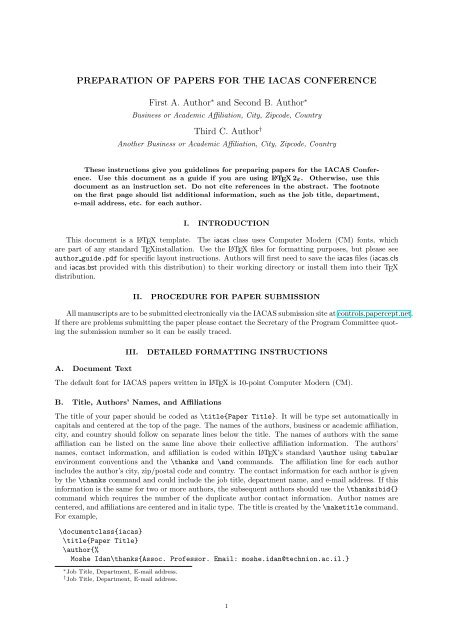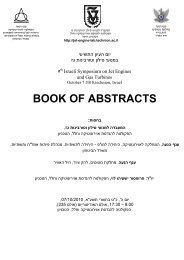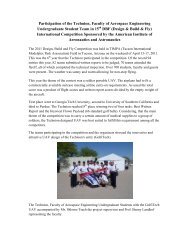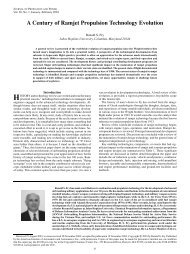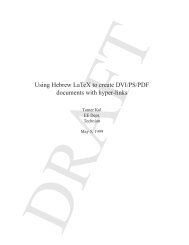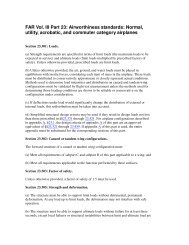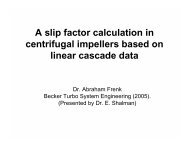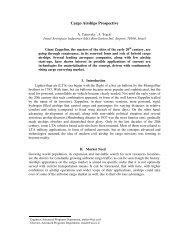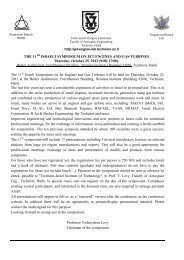PREPARATION OF PAPERS FOR THE IACAS CONFERENCE First ...
PREPARATION OF PAPERS FOR THE IACAS CONFERENCE First ...
PREPARATION OF PAPERS FOR THE IACAS CONFERENCE First ...
Create successful ePaper yourself
Turn your PDF publications into a flip-book with our unique Google optimized e-Paper software.
<strong>PREPARATION</strong> <strong>OF</strong> <strong>PAPERS</strong> <strong>FOR</strong> <strong>THE</strong> <strong>IACAS</strong> <strong>CONFERENCE</strong><br />
<strong>First</strong> A. Author ∗ and Second B. Author ∗<br />
Business or Academic Affiliation, City, Zipcode, Country<br />
Third C. Author †<br />
Another Business or Academic Affiliation, City, Zipcode, Country<br />
These instructions give you guidelines for preparing papers for the <strong>IACAS</strong> Conference.<br />
Use this document as a guide if you are using L ATEX 2ε. Otherwise, use this<br />
document as an instruction set. Do not cite references in the abstract. The footnote<br />
on the first page should list additional information, such as the job title, department,<br />
e-mail address, etc. for each author.<br />
I. INTRODUCTION<br />
This document is a L ATEX template. The iacas class uses Computer Modern (CM) fonts, which<br />
are part of any standard TEXinstallation. Use the L ATEX files for formatting purposes, but please see<br />
author guide.pdf for specific layout instructions. Authors will first need to save the iacas files (iacas.cls<br />
and iacas.bst provided with this distribution) to their working directory or install them into their TEX<br />
distribution.<br />
II. PROCEDURE <strong>FOR</strong> PAPER SUBMISSION<br />
All manuscripts are to be submitted electronically via the <strong>IACAS</strong> submission site at controls.papercept.net.<br />
If there are problems submitting the paper please contact the Secretary of the Program Committee quoting<br />
the submission number so it can be easily traced.<br />
A. Document Text<br />
III. DETAILED <strong>FOR</strong>MATTING INSTRUCTIONS<br />
The default font for <strong>IACAS</strong> papers written in L ATEX is 10-point Computer Modern (CM).<br />
B. Title, Authors’ Names, and Affiliations<br />
The title of your paper should be coded as \title{Paper Title}. It will be type set automatically in<br />
capitals and centered at the top of the page. The names of the authors, business or academic affiliation,<br />
city, and country should follow on separate lines below the title. The names of authors with the same<br />
affiliation can be listed on the same line above their collective affiliation information. The authors’<br />
names, contact information, and affiliation is coded within L ATEX’s standard \author using tabular<br />
environment conventions and the \thanks and \and commands. The affiliation line for each author<br />
includes the author’s city, zip/postal code and country. The contact information for each author is given<br />
by the \thanks command and could include the job title, department name, and e-mail address. If this<br />
information is the same for two or more authors, the subsequent authors should use the \thanksibid{}<br />
command which requires the number of the duplicate author contact information. Author names are<br />
centered, and affiliations are centered and in italic type. The title is created by the \maketitle command.<br />
For example,<br />
\documentclass{iacas}<br />
\title{Paper Title}<br />
\author{%<br />
Moshe Idan\thanks{Assoc. Professor. Email: moshe.idan@technion.ac.il.}<br />
∗ Job Title, Department, E-mail address.<br />
† Job Title, Department, E-mail address.<br />
1
and Haim Cohen \thanks{Graduate Student. Email: haim.cohen@technion.ac.il.} \\<br />
{\itseries Faculty of Aerospace Engineering, Technion, Haifa, 32000, Israel} \\<br />
\and<br />
Someone Else\thanks{Job Title, Department, E-mail.}\\<br />
{\itseries Another Business or Academic Affiliation, City, Zipcode, Country}<br />
}<br />
\begin{document}<br />
\maketitle<br />
C. Headings<br />
<strong>IACAS</strong> conference style defines 3 levels of section headings:<br />
Level 1 heading (\section): bold, larger font, centered, and numbered with Roman numerals.<br />
Level 2 heading (\subsection): bold, flush left, and numbered with capital letters. No opening paragraph<br />
indentation.<br />
Level 3 heading (\subsubsection): italic, flush left, and numbered with Arabic numbers (e.g., 1, 2, 3).<br />
No opening paragraph indentation.<br />
D. Abstract<br />
The abstract should appear at the beginning of your paper. It should be one paragraph long (not an<br />
introduction) and complete in itself (no reference numbers). It should indicate subjects dealt with in<br />
the paper and state the objectives of the investigation. Newly observed facts and conclusions of the<br />
experiment or arguments discussed in the paper must be stated in summary form; readers should not<br />
have to read the paper to understand the abstract.<br />
E. Footnotes<br />
Footnotes, where they appear, should be placed above the 1-inch margin at the bottom of the page. To<br />
insert footnotes, use \footnote{} as normal. Footnotes are formatted automatically in iacas.cls, but<br />
if another medium is used, they should appear in as superscript lower case letters. When adding notes to<br />
tables, e.g., as accommodated by the threeparttable package, the symbols should be in the sequence<br />
*, †, ‡, §, , , **, ††, and so forth. This sequence should begin anew with each table.<br />
F. References<br />
List and number all bibliographical references at the end of the paper. Corresponding numbers in square<br />
brackets are used to cite references in the text using the \cite{} command, [1] unless the citation is an<br />
integral part of the sentence (e.g., “It is shown in Ref. 2 that. . . [.]”) or follows a mathematical expression:<br />
“A2 + B = C (Ref. 3).” For this case, the command, \citen{} is used. Multiple citations are sorted<br />
and punctuated automatically through the iacas’s use of the cite package. Separate reference numbers<br />
are shown with commas [1,2,4] and ranges are separated by an en-dash [1–3]. Reference citations in the<br />
text should be in numerical order, which is assured by using BibTEX.<br />
In the reference list, give all authors’ names; do not use “et al.” unless there are six authors or more.<br />
Papers that have not been published should be cited as “unpublished”; papers that have been submitted<br />
or accepted for publication should be cited as “submitted for publication.” Private communications and<br />
personal Web sites should appear as footnotes rather than in the reference list.<br />
References should be cited according to the standard publication reference style. (For examples, see<br />
the “References” section of this template.) This is facilitated by the BibTEX database and a style file,<br />
iacas.bst. As a rule, all words are capitalized except for articles, conjunctions, and prepositions of four<br />
letters or fewer. Names and locations of publishers should be listed; month and year should be included<br />
for reports and papers.<br />
In the Reference section at the end of this guide you can see some samples of bibliography entries<br />
of various type (articles, books, etc.) Not all of those references were used in this text. The entire list,<br />
included in the bibtex database.bib sample file, was generated using the \cite{*} command. []<br />
2
G. Images, Figures, and Tables<br />
All artwork, captions, figures, graphs, and tables will be reproduced exactly as submitted. Be sure to<br />
position any figures, tables, graphs, or pictures as you want them printed.<br />
Place figure captions below all figures; place table titles above the tables. a If your figure has multiple<br />
parts, include the labels “a),” “b),” and so on, below each subfigure and above the figure caption. This<br />
can be accomplished with the subfigure package. Please verify that the figures and tables you mention<br />
in the text actually exist by using L ATEX’s \label and \ref mechanisms and verifying that there are no<br />
undefined references during typesetting.<br />
Figures and tables are referred to as ‘Floats’ in L ATEX, reflecting their floating nature. They are<br />
typically numbered whether or not they have a caption and they are floated to the first available position<br />
near the first reference to that figure/table within the text. This is accomplished by placing the<br />
figure/table environment after their first reference. By default, floats are placed at the top of the first<br />
available page, the bottom of the page, or one a page consisting entirely of floats.<br />
Figure 1. Magnetization as a function of applied field. This figure demonstrates the dangers of using a<br />
bitmap as opposed to a vector image.<br />
Table 1 was typeset using the threeparttable package (see author guide.tex for specifics).<br />
H. Equations<br />
Table 1. This is an example of a threeparttable which<br />
uses the dcolumn package to allow for columns to be<br />
aligned on decimal points.<br />
<strong>First</strong> head * Second head Third head VM (r)<br />
center doctor 0.2 10.55<br />
tab dentist 0.15 33.12<br />
worse man † 10.58 45.10<br />
better home 43.9 12.34<br />
* This is a table footnote, which to span multiple lines, has<br />
been greatly extended in length contrary to reason.<br />
† A much shorter table footnote.<br />
Equations are centered and numbered consecutively, with equation numbers in parentheses flush right.<br />
Several examples of such equations are:<br />
L (µ; t, x, z) = 1<br />
2π<br />
∞<br />
−1<br />
∂µ (t, x ′ )<br />
∂x ′<br />
a Please do not include captions as part of the figure image itself.<br />
(x − x ′ ) dx ′<br />
(x − x ′ ) 2 , (1)<br />
+ z2 Ji · ∆x i+1 = −f i , (2)<br />
3
and<br />
I0(x) =<br />
I. General Grammar and Preferred Usage<br />
∞<br />
n x<br />
n=0<br />
2 n n!<br />
2<br />
. (3)<br />
Use only one space after periods or colons. Hyphenate complex modifiers: “zero-field-cooled magnetization.”<br />
Avoid dangling participles, such as, “Using Eq. (1), the potential was calculated.” [It is not clear<br />
who or what used Eq. (1).] Write instead “The potential was calculated using Eq. (1),” or “Using Eq.<br />
(1), we calculated the potential.”<br />
Use a zero before decimal points: “0.25,” not “.25.” Use “cm 3 ,” not “cc.” Indicate sample dimensions<br />
as “0.1 cm × 0.2 cm,” not “0.1 × 0.2 cm 2 .” The preferred abbreviation for “seconds” is “s,” not “sec.”<br />
Do not mix complete spellings and abbreviations of units: use “Wb/m 2 ” or “webers per square meter,”<br />
not “webers/m 2 .” When expressing a range of values, write “7 to 9” or “7–9,” not “7 9.”<br />
A parenthetical statement at the end of a sentence is punctuated outside of the closing parenthesis<br />
(like this). (A parenthetical sentence is punctuated within parenthesis.) In American English, periods<br />
and commas are placed within quotation marks, like “this period.” Other punctuation is “outside”!<br />
Avoid contractions; for example, write “do not” instead of “don’t.” The serial comma is preferred: “A,<br />
B, and C” instead of “A, B and C.”<br />
If you wish, you may write in the first person singular or plural and use the active voice (“I observed<br />
that. . . ” or “We observed that. . . ” instead of “It was observed that”). Remember to check spelling. If<br />
your native language is not English, please ask a native English-speaking colleague to proofread your<br />
paper.<br />
The word “data” is plural, not singular (i.e., “data are,” not “data is”). The subscript for the<br />
permeability of vacuum µ0 is zero, not a lowercase letter “oo.” The term for residual magnetization<br />
is “remanence”; the adjective is “remanent”; do not write “remnance” or “remnant.” The word “micrometer”<br />
is preferred over “micron” when spelling out this unit of measure. A graph within a graph<br />
is an “inset,” not an “insert.” The word “alternatively” is preferred to the word “alternately” (unless<br />
you really mean something that alternates). Use the word “whereas” instead of “while” (unless you<br />
are referring to simultaneous events). Do not use the word “essentially” to mean “approximately” or<br />
“effectively.” Do not use the word “issue” as a euphemism for “problem.” When compositions are<br />
not specified, separate chemical symbols by en-dashes; for example, “NiMn” indicates the intermetallic<br />
compound Ni0.5Mn0.5 whereas “Ni–Mn” indicates an alloy of some composition NixMn1−x.<br />
Be aware of the different meanings of the homophones “affect” (usually a verb) and “effect” (usually<br />
a noun), “complement” and “compliment,” “discreet” and “discrete,” “principal” (e.g., “principal<br />
investigator”) and “principle” (e.g., “principle of measurement”). Do not confuse “imply” and “infer.”<br />
Prefixes such as “non,” “sub,” “micro,” “multi,” and “ultra” are not independent words; they should<br />
be joined to the words they modify, usually without a hyphen. There is no period after the “et” in the<br />
abbreviation “et al.” The abbreviation “i.e.,” means “that is,” and the abbreviation “e.g.,” means “for<br />
example” (these abbreviations are not italicized).<br />
IV. CONCLUSION<br />
The paper should end with a conclusion (or summary) section. Although the conclusions may review<br />
the main points of the paper, do not replicate the abstract as the conclusions. The conclusions should<br />
elaborate on the importance of the work or suggest applications and extensions. b<br />
ACKNOWLEDGMENTS<br />
The preferred spelling of the word “acknowledgment” in American English is without the “e” after<br />
the “g.” Avoid expressions such as “One of us (S.B.A.) would like to thank. . . [.]” Instead, write “F.<br />
A. Author thanks. . . [.]” Sponsor and financial support acknowledgments are also to be listed in the<br />
acknowledgments section.<br />
b The conclusion section is the last section of the paper that should be numbered. Acknowledgments, appendix (if<br />
present), and references should be listed without numbers.<br />
4
APPENDIX<br />
An appendix, if needed, should appear after the acknowledgments. Use the ‘starred’ version of the<br />
\section commands to avoid section numbering.<br />
REFERENCES<br />
1. Sutton, K., “Air Radiation Revisited,” Thermal Design of Aeroassisted Orbital Transfer Vehicles,<br />
edited by H. F. Nelson, Vol. 96, AIAA, New York, 1985, pp. 419–441.<br />
2. Miner, E. W. and Lewis, C. H., “Hypersonic Ionizing Air Viscous Shock-Layer Flows over Nonanalytic<br />
Blunt Bodies,” NASA CR–2250, May 1975.<br />
3. Wirin, W. B., “Space Debris 1989,” Proceedings of the Thirty-Second Colloquium on the Law of<br />
Outer Space, AIAA, Wahington, DC, 1990, pp. 184–196.<br />
4. Turner, M. J., Martin, H. C., and Leible, R. C., “Further Development and Applications of<br />
Stiffness Methods,” Matrix Methods of Structural Analysis, Vol. 1, Macmillian, New York, 1st ed., 1964,<br />
pp. 203–266.<br />
5. Bhutta, B. A. and Lewis, C. H., “Large-Angle-of-Attack Viscous Hypersonic Flows over Complex<br />
Lifting Configurations,” Journal of Spacecraft and Rockets, Vol. 27, No. 2, 1990, pp. 194–204, also AIAA<br />
Paper 89–0269, Jan. 1989.<br />
6. Blottner, F. G., “Prediction of Electron Density in the Boundary Layer of Entry Vehicles with<br />
Ablation,” The Entry Plasma Sheath and Its Effects, Vol. 1, Oct. 1970, pp. 219–240.<br />
7. Bhutta, B. A. and Lewis, C. H., “PNS Predictions of External/Internal Hypersonic Flows for<br />
NASP Propulsion Applications,” Vra–tr–90–01, VRA, Inc., Blacksburg, VA, June 1990.<br />
8. Bhutta, B. A. and Lewis, C. H., “Aerothermodynamic Performance of 3-D and Bent-Nose RVs<br />
Hypersonic Conditions,” AIAA Paper 90–3068, Aug. 1990.<br />
9. Anon., “Equations, Tables, and Charts for Compressible Flow,” NACA Rept. 1135, 1953.<br />
10. Moss, J. N., private communication, NASA Langley Research Center, Hampton, VA, June 1990.<br />
11. Tufte, E. R., The Visual Display of Quantitative Information, Graphics Press, Cheshire, CT,<br />
1983.<br />
12. Thoman, D. C., Numerical Solutions of Time Dependent Two Dimensional Flow of a Viscous,<br />
Incompressible Fluid Over Stationary and Rotating Cylinders, Ph.D. thesis, University of Notre Dame,<br />
Indiana, Aug. 1966.<br />
5


